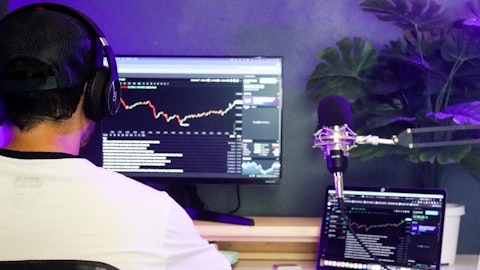Daniel Ordonez: Yes. I will try my best to answer what’s behind your question, Kaumil, which is our progress in retail — in the retail space and I’ll try to comment in the evident question about shelf space, which is, obviously, we’re tracking and we’re gaining, right? Although, data is very recent and I won’t be able to fully share that with you today. But as you saw in the prepared remarks, Kaumil, the team is delivering some very significant distribution gains, consistent with the discussions we had in previous ones, in previous quarters. As you heard us talking about controlling the controllables, we were able to drive TDPs growth above 50%, five-zero. The ACVs have grown for above 1,000 basis points year-on-year to 43% and still counting.
There is more room to go there in terms of TDPs and ACV, so weighted distribution, because, Kaumil, generated the highest ever market share in oat milk. You guys are tracking the scanner data. I know you are. Above 25% for oat milk and 6% across all plant-based drinks. The traction you might have seen in the recent scanner data with solid growth in both units and dollars in our core business. We believe, yes, indeed, shelfs is growing, distribution is growing and we see this only the beginning. You know, Kaumil, we are the only category pure player in oat milk, and we are the brand that has proven to drive category penetration. So holding that unique space and with so much plenty of ACV runway ahead, there is more to come and more to go. With supply chain reliability issues behind and having regained distribution, we expect steady progress on distribution and sales execution to drive further profitable growth.
Hope that answers your question, Kaumil.
Operator: Our next question comes from Andrew Lazar with Barclays.
Andrew Lazar: Great. Thanks so much. Good morning, everybody. I guess, I’m curious about the cadence of EBITDA as we move through 2024. EBITDA obviously improved sequentially each quarter through 2023. I guess I’m curious whether this pattern continues as we start ’24, meaning sequential improvement or are there reasons that perhaps EBITDA losses expand again versus the fourth quarter as we move into the first half? And if so, why? Because I think I heard you say that EBITDA dollars would be concentrated more in the back half. So maybe I’ve answered my own question, but I’m trying to get a sense of how you see the EBITDA cadence going as we go through the year and what the rationale behind that cadence would be?
Marie-Jose David: Hi, Andrew. This is Marie-Jose. Very nice meeting you. I will answer in two steps when it comes to your question. So the first one is, over the past 12 months, right, you know that we have established a foundation to drive a better business towards profitable growth. It’s true that last year, we guided to quarterly improvement, but we thought that it’s more natural out of these 12 months of establishing conditions that we look more at the long-term time horizon then just the upcoming quarter. So this is just to give you an overview of why we are not driving quarter-over-quarter anymore. Now, as you mentioned and you just said it, right, our guidance calls for the second half to be stronger than the first half.
On sales growth and on EBITDA and this is true as well for gross margin. We are not guiding to quarters, but the first quarter, as I just said, we obviously have some dynamics such as the Chinese New Year, such as the spend from new products, new distribution driving swapping Span and Trade Support. I mean, you’ve heard us saying that two times already. Also, as I mentioned in the prepared remarks, right, we are working on eliminating cost through profitability and efficiency programs. So, it’s now my answer to the question on EBITDA. Our EBITDA will be between $35 million and $60 million, which, again, I want to emphasize, the year-over-year improvement between $98 million and $123 million. So out of this improvement, just to be very precise, we are expecting roughly $20 million to $25 million to come from SG&A reduction.
As a reminder, SG&A includes distribution costs, and we know those are pretty variable. And the remaining portion of this EBITDA improvement will come from gross profit. So, in a nutshell, there is no guidance on quarter-over-quarter. There is more annual and long-term view understanding, as I just said that the second half will be stronger than the first half and this is all about from top line to bottom line.
Andrew Lazar: And then you talked a little about this in the prepared remarks, but I want to make sure I have it right. Despite a lot of the sequential progress that you clearly have been making and you’ve talked about, you’ve pushed back the timing on getting to EBITDA positive right several times now. And I think don’t expect it this year either it would seem. I guess if you had to like just boil it down and sort of bucket it into maybe the top couple of things that have been the main rationale or reason for that shifting and why maybe the visibility to that hasn’t been what you would have wanted it to be. Like, what would those be? What I’m trying to assess is, why has it gotten push back, why would your visibility to the EBITDA guidance you’re providing for this year be more solid maybe than what it’s been in whatever past couple of quarters, if you kind of get my point? Thank you.



